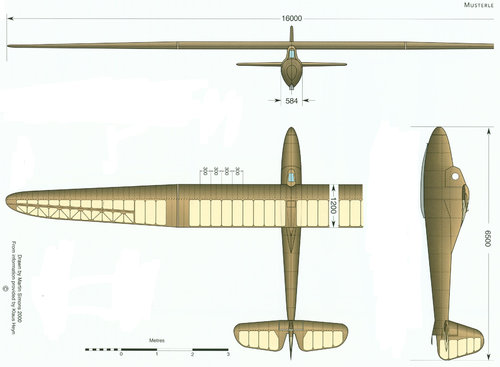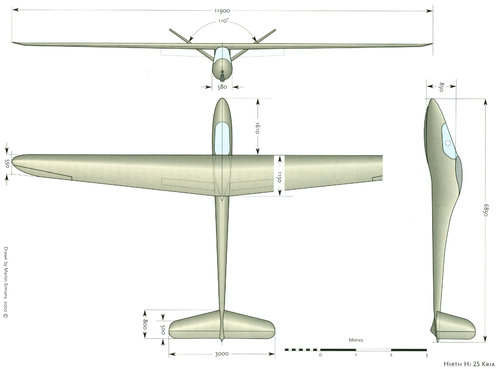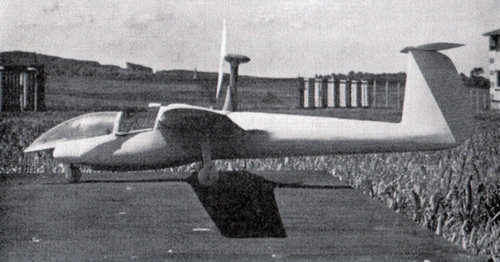- Joined
- 25 July 2007
- Messages
- 4,152
- Reaction score
- 3,795
Wolfram ('Wolf') Kurt Erhard Hirth - 1900-1959
Wolf Hirth was a well-known glider pilot who had earned his pilot's licence in 1920. He was also the younger brother of Hellmuth Hirth, founder of Hirth Motoren GmbH. After graduating from the Technischen Hochschule Stuttgart in 1928 with an engineering degree, Wolf Hirth toured the world given gliding demonstrations. Like Hellmuth, Wolf stayed briefly in the United States. It was in the US that Hirth made his first foray into manufacturing gliders.
In 1931, a joint venture was formed with Augustine ('Gus') Haller in Pittsburgh, PA - the Haller-Hirth Sailplane Corporation (sometimes listed as the Haller-Hirth Sailplane Manufacturing Company). Haller-Hirth Sailplane Corp. ran a flying school (Haller School Of Soaring Flight, Greensburg, PA) with fellow German glider pilot, Martin Schempp as chief flying instructor (and company secretary). The firm also imported German-made glider kits and sold or assembled them for the US market.
The first Haller-Hirth 'product' was the 1931 single-seat Haller Hawk - an imported RRG (Rhon-Rossitten-Gesellschaft) Professor kit assembled in the Haller family garage in Mt. Lebanon, a suburb of Pittsburgh. Other Haller-Hirth gliders offered to the US market were the 2-seat Haller-Hirth K-20 Junior Hawk (Kassel Flugzeugbau Kassel 20 kits) and the Haller-Hirth Sparrow primary glider (Rhon-Rossitten-Gesellschaft RRG-1 Zögling kits).
A brief chronology of Wolf Hirth's career follows:
1933 - Wolf Hirth (and Martin Schempp) return to Germany*
-- * Some sources list date as 1934 (but see next chronology entry)
1933 - Lecturer at his alma mater, the Technischen Hochschule Stuttgart (THS)
1935 - Hirth is 'silent partner' in Sportflugzeugbau Göppingen Martin Schempp
1937 - Sportflugzeugbau Göppingen Martin Schempp moves to Kirchheim unter Teck*
-- Other souces list Kircheim/Teck move date as 1938 (see later entry)
1938 - Wolf Hirth officially joins Schempp company as partner (and shareholder)
-- Company is renamed Sportflugzeugbau Schempp-Hirth OHG
1938 - Schempp-Hirth OHG moves to Kirchheim/Teck (date according to corporation)
-- Wolfgang Hütter brings Gö 4 design, Ulrich Hütter brings his H 17 (as Gö 5)
1939 - Wolf Hirth GmbH founded in Nabern/Teck
1939-41 Wold Hirth conscripted (basic glider training in East Prussia)
1940 - Wolf Hirth GmbH begins component assembly for military aircraft makers
1945 - Schempp-Hirth begins the prod. of wooden furniture, parts, etc.
1950-51 - Martin Schempp abandons glider building to benefit Wolf Hirth
1956 - Schempp-Hirth begins building powered aircraft
1960 - After Hirth's death, Martin Schempp starts building gliders again
1962 - Schempp-Hirth develops license-built Standard Austria S glider
_________________________________________________________________________
The Aircraft Designs of Wolfram ('Wolf') Kurt Erhard Hirth (1900-1959)
Early on, Wolf Hirth helped design a number of gliders at Göttingen. Most of these, grouped here, fall within other designer's designation systems. The exception is the 1931 Hirth Hi II prototype.
The Hirth Hi II designation suggests an earlier 'Hi I' but I've found no direct evidence of such an aircraft. But there is a possible hint in history of FAG I (Flug- und Arbeitsgruppe I/Flight and Working Group I) at Göppingen. At the 1929 founding of FAG I, construction of two basic training gliders was initiated. One was an enclosed ("verkleideter") type (likely the Hi II, below), the other was an "offener" type (presumably meaning open framed). Was this open Göppingen glider the 'missing' Hirth Hi I?
Early Wolf Hirth Aircraft Designs
Laubenthal Württemberg - 1927 single-seat sailplane, span 15.2 m
- Württemberg: Unbraced parasol, desig. with Paul Laubenthal
Schneider Grunau Baby II A - 1929 training glider, span 14.5 m
- Schneider Grunau Baby: Braced parasol wing training glider
-- Desig. by Edmund Schneider and Wolf Hirth, Göttingen airfoils
Hirth Hi I -- [??]
Hirth Hi II - 1931 pod-and-boom training glider, span 10.8 m, x 1
- Hi II: Named 'Dolf', Gründung der FAG I (Flug- und Arbeitsgruppe I)
-- http://www.j2mcl-planeurs.net/dbj2mcl/planeurs-machines/planeur-fiche_0int.php?code=3745
Grunau 7 Moazagotl - 1933 high-performance glider by Wolf Hirth
- Grunau 7 Moazagotl*: Braced gull-wing, span 20 m, 1 x prototype
-- Desig. by Friedrich Wenk and Wolf Hirth, Göttingen airfoil sections
-- * The Moazagoatl is a föhn-type wind of the Sudeten Mountains
-- http://www.knzink.de/moazagotl/b1.jpg
Grunau 8 - 1935 Schneider Grunau 8 training glider, span 14.5 m
- Grunau 8: Braced parsol, built by Edmund Schneider Grunau (ESG)
-- Desig. by Edmund Schneider and Wolf Hirth, Göttingen airfoils
_________________________________________________________________________
Wolf Hirth was a well-known glider pilot who had earned his pilot's licence in 1920. He was also the younger brother of Hellmuth Hirth, founder of Hirth Motoren GmbH. After graduating from the Technischen Hochschule Stuttgart in 1928 with an engineering degree, Wolf Hirth toured the world given gliding demonstrations. Like Hellmuth, Wolf stayed briefly in the United States. It was in the US that Hirth made his first foray into manufacturing gliders.
In 1931, a joint venture was formed with Augustine ('Gus') Haller in Pittsburgh, PA - the Haller-Hirth Sailplane Corporation (sometimes listed as the Haller-Hirth Sailplane Manufacturing Company). Haller-Hirth Sailplane Corp. ran a flying school (Haller School Of Soaring Flight, Greensburg, PA) with fellow German glider pilot, Martin Schempp as chief flying instructor (and company secretary). The firm also imported German-made glider kits and sold or assembled them for the US market.
The first Haller-Hirth 'product' was the 1931 single-seat Haller Hawk - an imported RRG (Rhon-Rossitten-Gesellschaft) Professor kit assembled in the Haller family garage in Mt. Lebanon, a suburb of Pittsburgh. Other Haller-Hirth gliders offered to the US market were the 2-seat Haller-Hirth K-20 Junior Hawk (Kassel Flugzeugbau Kassel 20 kits) and the Haller-Hirth Sparrow primary glider (Rhon-Rossitten-Gesellschaft RRG-1 Zögling kits).
A brief chronology of Wolf Hirth's career follows:
1933 - Wolf Hirth (and Martin Schempp) return to Germany*
-- * Some sources list date as 1934 (but see next chronology entry)
1933 - Lecturer at his alma mater, the Technischen Hochschule Stuttgart (THS)
1935 - Hirth is 'silent partner' in Sportflugzeugbau Göppingen Martin Schempp
1937 - Sportflugzeugbau Göppingen Martin Schempp moves to Kirchheim unter Teck*
-- Other souces list Kircheim/Teck move date as 1938 (see later entry)
1938 - Wolf Hirth officially joins Schempp company as partner (and shareholder)
-- Company is renamed Sportflugzeugbau Schempp-Hirth OHG
1938 - Schempp-Hirth OHG moves to Kirchheim/Teck (date according to corporation)
-- Wolfgang Hütter brings Gö 4 design, Ulrich Hütter brings his H 17 (as Gö 5)
1939 - Wolf Hirth GmbH founded in Nabern/Teck
1939-41 Wold Hirth conscripted (basic glider training in East Prussia)
1940 - Wolf Hirth GmbH begins component assembly for military aircraft makers
1945 - Schempp-Hirth begins the prod. of wooden furniture, parts, etc.
1950-51 - Martin Schempp abandons glider building to benefit Wolf Hirth
1956 - Schempp-Hirth begins building powered aircraft
1960 - After Hirth's death, Martin Schempp starts building gliders again
1962 - Schempp-Hirth develops license-built Standard Austria S glider
_________________________________________________________________________
The Aircraft Designs of Wolfram ('Wolf') Kurt Erhard Hirth (1900-1959)
Early on, Wolf Hirth helped design a number of gliders at Göttingen. Most of these, grouped here, fall within other designer's designation systems. The exception is the 1931 Hirth Hi II prototype.
The Hirth Hi II designation suggests an earlier 'Hi I' but I've found no direct evidence of such an aircraft. But there is a possible hint in history of FAG I (Flug- und Arbeitsgruppe I/Flight and Working Group I) at Göppingen. At the 1929 founding of FAG I, construction of two basic training gliders was initiated. One was an enclosed ("verkleideter") type (likely the Hi II, below), the other was an "offener" type (presumably meaning open framed). Was this open Göppingen glider the 'missing' Hirth Hi I?
Early Wolf Hirth Aircraft Designs
Laubenthal Württemberg - 1927 single-seat sailplane, span 15.2 m
- Württemberg: Unbraced parasol, desig. with Paul Laubenthal
Schneider Grunau Baby II A - 1929 training glider, span 14.5 m
- Schneider Grunau Baby: Braced parasol wing training glider
-- Desig. by Edmund Schneider and Wolf Hirth, Göttingen airfoils
Hirth Hi I -- [??]
Hirth Hi II - 1931 pod-and-boom training glider, span 10.8 m, x 1
- Hi II: Named 'Dolf', Gründung der FAG I (Flug- und Arbeitsgruppe I)
-- http://www.j2mcl-planeurs.net/dbj2mcl/planeurs-machines/planeur-fiche_0int.php?code=3745
Grunau 7 Moazagotl - 1933 high-performance glider by Wolf Hirth
- Grunau 7 Moazagotl*: Braced gull-wing, span 20 m, 1 x prototype
-- Desig. by Friedrich Wenk and Wolf Hirth, Göttingen airfoil sections
-- * The Moazagoatl is a föhn-type wind of the Sudeten Mountains
-- http://www.knzink.de/moazagotl/b1.jpg
Grunau 8 - 1935 Schneider Grunau 8 training glider, span 14.5 m
- Grunau 8: Braced parsol, built by Edmund Schneider Grunau (ESG)
-- Desig. by Edmund Schneider and Wolf Hirth, Göttingen airfoils
_________________________________________________________________________













